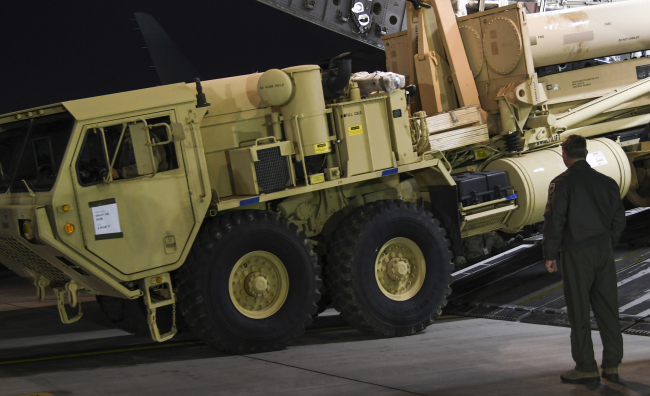The United States has begun the process of deploying an advanced missile defense system to South Korea, the US and South Korean militaries said Tuesday, a day after North Korea test-fired four ballistic missiles into the sea near Japan.
Seoul and Washington have said the system is purely defensive and poses no threat to other countries in the region. But China has explicitly opposed it, saying the Terminal High Altitude Area Defense system's powerful radars could be used against it.
 |
Parts of THAAD system arrive in Korea (Yonhap) |
"The deployment could be completed within one or two months and it can be operational as early as April," a Seoul military official told reporters.
The first elements of the system, including two launchers, arrived at Osan Air Base in Pyeongtaek, 70 kilometers south of Seoul, Monday, the two militaries said.
A C-17 Globemaster III transport aircraft has delivered the first elements of the THAAD system, including two launchers, which will be transferred from the US air base to the southeastern rural county of Seongju, 296 kilometers south of Seoul, the site for the battery, Moon Sang-gyun, a spokesman for the defense ministry, told reporters.
He didn't provide a schedule for the transfer. The remaining equipment is expected to be gradually delivered here, he said without elaborating.
Since they agreed in July to install a THAAD battery in South Korea by the end of 2017, Seoul and Washington have stepped up their efforts to bring it "as quickly as possible" due to evolving nuclear and missile threats from the North, the US Forces Korea said in a statement.
 |
Parts of THAAD system arrive in Korea (Yonhap) |
On Monday, Pyongyang test-fired four ballistic missiles, which Seoul's military said are upgraded versions of Scud missiles, in an apparent protest against ongoing US-South Korean military drills that it views as an invasion rehearsal.
The rocket launch was a training exercise for a strike on US bases in Japan and supervised by leader Kim Jong-un, Pyongyang's state media said Monday.
"Continued provocative actions by North Korea, including Monday's launch of multiple missiles, only confirm the prudence of our alliance decision last year to deploy THAAD to South Korea," Adm. Harry Harris, who heads the US Pacific Command, said in a statement.
"We will resolutely honor our alliance commitments to South Korea and stand ready to defend ourselves, the American homeland and our allies," he said.
A THAAD battery consists of six truck-mounted launchers, 48 interceptors (eight per launcher), a fire control and communications unit, and an AN/TPY-2 radar.
"The timely deployment of the THAAD system by US Pacific Command and the Secretary of Defense gives my command great confidence in the support we will receive when we ask for reinforcements or advanced capabilities," said USFK Commander Gen. Vincent K. Brooks in another statement.
The deployment of THAAD contributes to a layered missile defense system and bolsters the allies' defense against North Korean missile threats, he said.
Meanwhile, China's foreign ministry said Tuesday it will take the "necessary steps to protect its security interests" which may be affected by the THAAD deployment in South Korea. (Yonhap)









